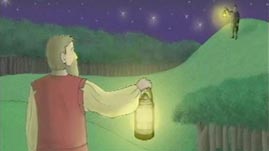Teachers' Domain - Digital Media for the Classroom and Professional Development
User: Preview

Source: Harvard—Smithsonian Center for Astrophysics
In this video segment adapted from Shedding Light on Science, learn about the finite speed of light. In the 1600s, Galileo investigated the speed of light by conducting an experiment with lanterns, but he was unsuccessful in determining whether light had a measurable speed. It wasn't until later that Danish astronomer Ole Roemer calculated a finite speed of light by studying Jupiter's moon, Io. See animations illustrating these historical examples and also see how light appears to travel instantaneously in our everyday lives.
The time delay between seeing a flash of lightning and hearing the rumble of thunder is an excellent demonstration of the finite speed of sound. The loud explosive noise we call thunder is produced as a result of a bolt of lightning heating the surrounding air extremely quickly. While the flash of light and the booming sound is produced at essentially the same time, you often see the lightning before you hear the thunder. This delay occurs because sound travels about a million times more slowly than light does.
Nowadays, we know that both sound and light travel at finite speeds. However, it wasn't always known that light has a measurable speed. Light travels so fast that, at the short distances we are used to in everyday life, it appears to travel instantaneously. From the time of Aristotle until the seventeenth century, it was generally believed that light traveled at an infinite speed.
However, in the 1600s, Italian astronomer Galileo became convinced that light, like sound, had a measurable speed. He tried to measure this speed by clocking how long it took for flashing lantern signals to travel back and forth between two hilltops. Unfortunately, because light travels so fast and human reaction time over such a short distance is unreliable, this method failed.
Not long after Galileo's experiment, Danish astronomer Ole Roemer studied the time it took for one of Jupiter's moons, Io, to complete its orbit. He observed that the amount of time it took Io to reappear from behind Jupiter—that is, for the light reflected from Io's surface to be seen by Roemer—varied, depending on the distance between Earth and Jupiter. If the speed of light was infinite, there should have been no such delay. Using the diameter of Earth's orbit and this time lag, Roemer calculated the speed of light as 227,000 kilometers per second (140,000 miles per second)—about one-quarter below the modern value of 300,000 km/s (186,000 mi/s). Inaccurate though it was, this was the first physical evidence that light had a finite speed.
So how fast is 300,000 km/s? Consider that it would take you about nine years to walk the distance between the Earth and the Moon. Sound would take approximately two weeks to travel that same distance. Light would only take about 1.3 seconds to make the trip!
 Loading Standards
Loading Standards Teachers' Domain is proud to be a Pathways portal to the National Science Digital Library.
Teachers' Domain is proud to be a Pathways portal to the National Science Digital Library.
